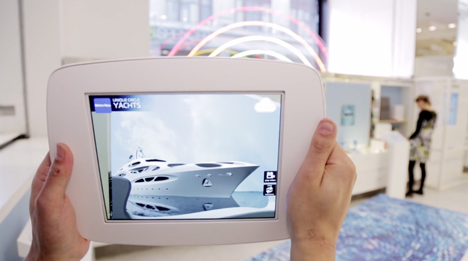Augmented reality technologies are rising rapidly across multiple markets. While virtual reality is blowing up in the entertainment industry, augmented reality is now being employed for a much wider variety of uses.
For marine vessels like superyachts, augmented reality has a place in every step of the process. Major shipyards, for instance, are using augmented reality to assist the ship-building process and to demonstrate superyacht concepts on a live, 3D scale. Importantly, they also have a place inside superyachts, particularly in the engine room.
Augmented vs Virtual Realities
Many people seem to confuse augmented reality (AR) with virtual reality (VR). While the two concepts seem to share some similarities, they are actually very distinct and easy to distinguish. The only strong similarity is that they both rely on some kind of virtual technology though they approach it very differently.
Augmented reality technologies allow you to view an actual location in real time and supplement virtual items on it. For instance, you can look through your smartphone’s camera and place items on an otherwise empty space. With virtual reality, the real world gets replaced by a virtual one, a digital space that has nothing to do with your actual location. 
Augmented Reality and Manufacturing
In a superyacht, everything must run smoothly all the time. The room for error is extremely small and the best shipyards have made a name for themselves by anticipating and responding to any potential pitfalls in the manufacturing process.
With augmented reality, managing the engine room is simpler than ever. Instead of creating new designs on a piece of paper or demonstrating them through a computer’s screen, engineers and manufacturers can now check out their work in real-time, in a virtual or actual space.
In case an engine has to be replaced or enhanced, for instance, an augmented reality app can be used to pinpoint the exact fixation points, how the new engine will fit into the room, how to add new items in an efficient manner, and more.
Training with augmented reality
For engineers and mechanics, there is a lot of potential in augmented reality technologies. Superyacht engine rooms change dramatically over the years as the luxury vessels tend to adopt the latest and greatest in emerging technologies. Hybrid engines, for example, are set to become the next big thing in the industry as environmental concerns are growing.
With augmented reality, learning about the specific quirks of any new technology can be incredibly easy. A camera pointed at a new piece of equipment can instantly provide the user with real-time information to add to their own knowledge base or even to assist them in completing certain tasks, something which would be extremely helpful in training.
The engine room of the future
Superyacht engines might be getting more complex but the crew that mans these vessels are also getting more training across a variety of disciplines. One of the greatest advantages of augmented reality is that it is easy to use but can be employed for extremely complex tasks.
Imagine, for example, a high-definition camera in the engine room linked to an augmented reality app in a crew member’s device. With a simple glance, they can retrieve real-time information on the performance of the engine without even having to be in the same space.
In another scenario, an engineer might be able to view the innards of the engine in order to determine the cause of a problem without having to dismantle a single part. Thus, the engine can run efficiently all the time with minimal risk.
Augmented reality technology is also evolving to include additional features. For example, an app dedicated to a specific engine will be able to determine its health via a combination of live video and audio, transfer that data back to a team of professionals, and allow them to determine a solution in a manner of minutes.

Overcoming augmented reality issues
Despite its many potential applications, augmented reality is far from perfect. First and foremost, the emerging technologies are not centered enough in the maritime industry to make a considerable difference, which means that they do not always work as expected.
Accuracy and precision is of the utmost importance in the engine room, something that augmented reality apps cannot always deliver. Augmenting a room or an engine often revolves around some guesswork so an experienced human eye is still necessary.
These issues can only be solved with the expansion and wider adoption of augmented reality technologies by manufacturers and individual superyachts. Generic apps and services are not sufficient so dedicated ones must be created for each superyacht. Then, the engine room will be able to operate more efficiently than ever before as augmented reality has the potential of disrupting the industry at its core.

